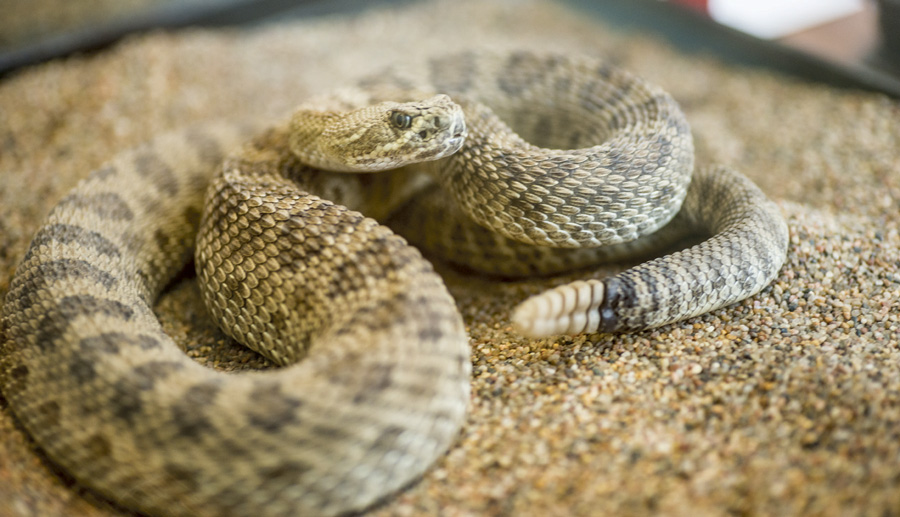Why did it have to be snakes? Because they’re awesome
Science by Stephen Whitworth

Snakes Alive: Snakes Of Saskatchewan
Royal Saskatchewan Museum
Opens May 20
Depending on the job, a great day at work looks different to everyone. On my latest great work day I got to sit at a desk across from the Royal Saskatchewan Museum’s Ray Poulin.
Poulin, the museum’s curator of zoology, is an interesting gentleman but what made my day great were the warily buzzing reptiles coiled inside tanks on his desk. It was my first face-to-face meeting with some of my favourite Saskatchewanians: the prairie rattlesnake, Crotalus viridus — one of nine species of snakes native to this province.
These rattlers, along with the eight other native Saskatchewan snake species, will be on display in the new RSM exhibit Snakes Alive: Snakes of Saskatchewan.
It promises to be an amazing exhibit, with interactive stations and informational displays. Poulin sees it as a chance to get away from the sensationalism and macho posturing that often surrounds these reptiles.
Instead of circus-sideshow shenanigans, museum visitors will learn about these misunderstood creatures through captive specimens and close-up photography that reveals an under-appreciated beauty.
“One of the things we’re trying to do with this exhibit is get away from that [nonsense],” says Poulin. “I don’t really want to promote people doing stupid things. These animals are no different than any other animals. You wouldn’t put a squirrel to your lips and kiss it, right? It’s no different with a snake.”
“What is the purpose of the rattle? It’s telling you, ‘leave me alone.’ It has no other purpose: it doesn’t attract prey. It’s a warning. They don’t want to fight, because they’re going to lose every time. So? ‘Back off, please. Don’t make me do this.’”
So what if you’re out in Southwest Saskatchewan and you meet a wild rattler?
For starters: don’t panic.
“Yes, these guys have venom, but they’re not going to go after you,” says Poulin. “I start my program by asking why snakes bite something, and there’s only ever two answers: they’re either trying to eat it — and humans are too big to consume — or they’re defending themselves. If you don’t want a snake to bite you in defence, use your legs and walk away.”
The room is quiet for a moment. Snakes don’t have ears, but the buzzing tails have stilled. Poulin has his audience’s attention.
Snakes Are Great And I Will Fight Anyone Who Says Different

Portrait of the author and his sidekick, Leonard, working on this story. DISCLAIMER: Leonard is a captive-bred pet. It is not appropriate to face-shnoonogle with wild Saskatchewan snakes.
This is the point in the article where I remind readers that Prairie Dog’s editor is a massive fan of snakes. I love them. I keep several as pets. I’m borderline obsessed.
Don’t get me wrong, I adore animals in general. Dogs are great. I lurve cats. If it’s furry and friendly I’ll happily hug it.
But I don’t have a dog at my feet as I’m typing this. I do, however, have a pet grey rat snake named Leonard perched on my desk.
Leonard is captive bred, descended from ancestors originally caught in the southeastern United States. You’d never find a wild rat snake in The Queen City. But Regina does have one wild species inside city limits: the plains garter snake. I’ve seen them around the Science Centre, and friends have reported seeing them on bike paths, in ditches and fields around town.
They’re pretty and they’re harmless. “It’s by far the most common species we have in Saskatchewan,” says Poulin. “It’s the one with an orange stripe down its back.
Thamnophix radix, as it’s known scientifically, is one of three Saskatchewan garter snakes.
“We also have the terrestrial garter snake,” says Poulin. “And we have a subspecies of the common garter snake called the red-sided garter snake. Its claim to fame is a couple of things. One: it’s the big dens, Narcisse in Manitoba and our big den in Saskatchewan too, at Fort Livingstone. Tens of thousands of snakes gathering in one place at one time. It’s an amazing sight.”
“The other claim to fame is it goes farther north than any other reptile in North America,”says Poulin. “You can find that species in the Northwest Territories.”
As mentioned, Snakes Alive will showcase all nine species of native snakes. Let’s do a roll call: besides rattlers and three species of garter snakes, Saskatchewan has the small and beautiful smooth green snake, the secretive red-bellied snake, two hissing divas in the western hog-nosed snake and majestic bullsnake, and the rare, and bitey, yellow-bellied racer. Of all of them, the only one presenting any potential danger to humans is the rattler.
But judging from the pair on Poulin’s desk — which, after more than an hour of Prairie Dog visitors getting too close to their tanks, haven’t struck even once — it’s pretty clear that as long as they’re given space and respect, they’re not going to bite anyone.
As for the question of beauty: I can’t see how it’s up for argument. Saskatchewan’s snakes are gorgeous creatures we should celebrate.
But you don’t have to take Prairie Dog’s crazy editor’s word for it. You can meet live, tongue flicking representatives of the entire spectacular, slithery family yourself at Snakes Alive when it opens later this month.
Hugs and hisses!
At 7:00 p.m. May 26, Ray Poulin will deliver an action-packed, serpent-filled lecture called “Talkin’ Bout Snakes” at the museum. Be there or snakes will get you!
(This story has been updated since publication.)





